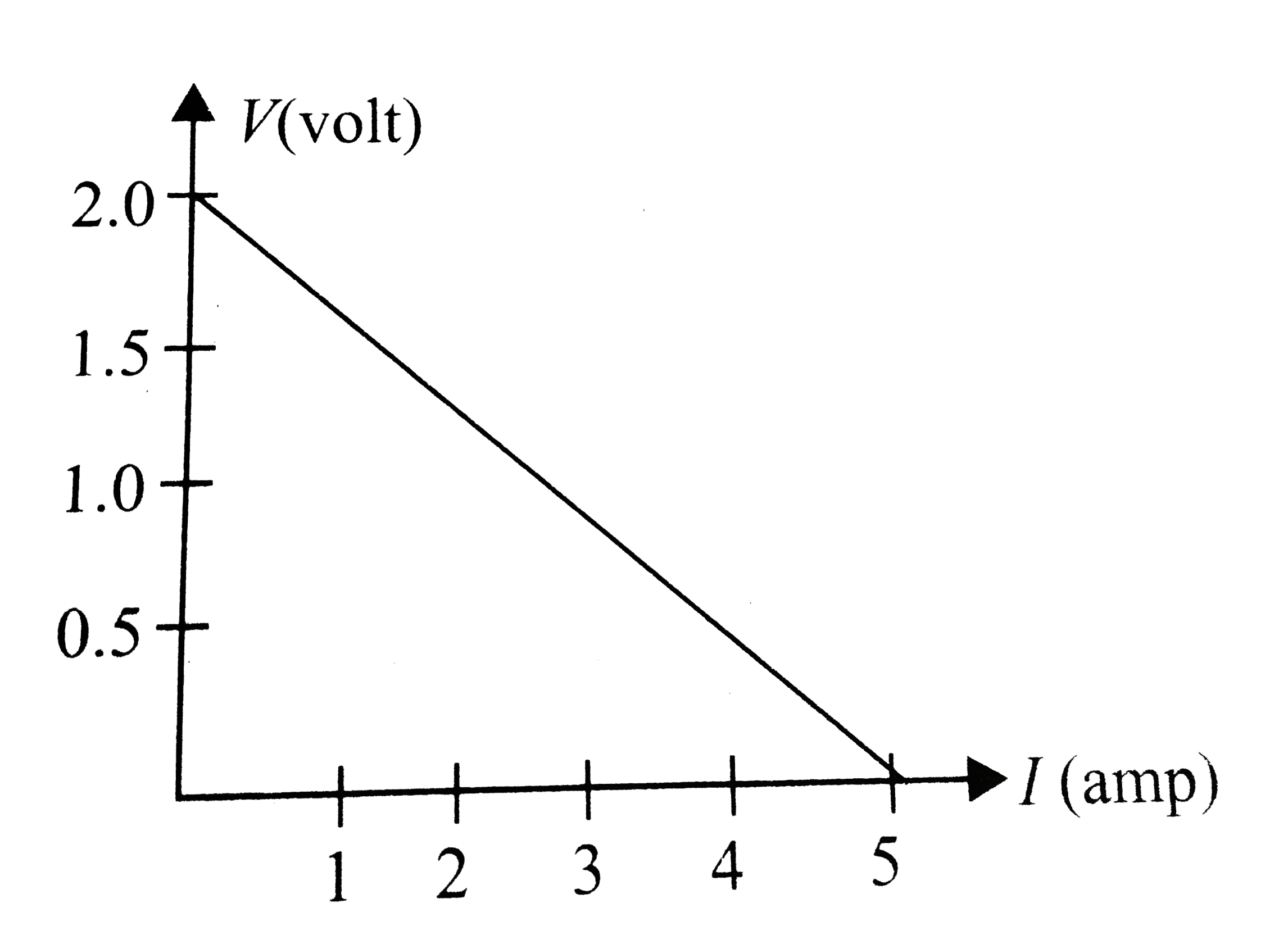The pd across terminals of a cell is found to be 29 volt and 28 volt respectively when it delivers a current of 1 ampere and 2 ampere respectively. The emf and internal resistance of a cell are respectively
30V,2Ω
30V,1Ω
29V,1Ω
28V,2Ω
The correct Answer is:B
To solve the problem, we need to find the electromotive force (emf) and the internal resistance of a cell based on the given terminal voltages at different currents.
1. Understanding the Problem:
We have two scenarios:
- When the current (I1) is 1 A, the terminal voltage (V1) is 29 V.
- When the current (I2) is 2 A, the terminal voltage (V2) is 28 V.
2. Using the Formula for Terminal Voltage:
The terminal voltage (V) can be expressed in terms of the emf (E) and internal resistance (r) as:
V=E−Ir
Rearranging gives:
E=V+Ir
3. Setting Up Equations:
For the first scenario (1 A):
E=29+1r(Equation 1)
For the second scenario (2 A):
E=28+2r(Equation 2)
4. Equating the Two Expressions for E:
Since both expressions equal E, we can set them equal to each other:
29+1r=28+2r
5. Solving for r:
Rearranging the equation gives:
29−28=2r−1r
1=r
Thus, the internal resistance r=1Ω.
6. Finding the Emf (E):
Now, we can substitute r back into either Equation 1 or Equation 2 to find E. Using Equation 1:
E=29+1⋅1=30V
Final Answers:
- The emf of the cell E=30V
- The internal resistance r=1Ω
We have two scenarios:
- When the current (I1) is 1 A, the terminal voltage (V1) is 29 V.
- When the current (I2) is 2 A, the terminal voltage (V2) is 28 V.
The terminal voltage (V) can be expressed in terms of the emf (E) and internal resistance (r) as:
V=E−Ir
Rearranging gives:
E=V+Ir
For the first scenario (1 A):
E=29+1r(Equation 1)
For the second scenario (2 A):
E=28+2r(Equation 2)
Since both expressions equal E, we can set them equal to each other:
29+1r=28+2r
Rearranging the equation gives:
29−28=2r−1r
1=r
Thus, the internal resistance r=1Ω.
Now, we can substitute r back into either Equation 1 or Equation 2 to find E. Using Equation 1:
E=29+1⋅1=30V
- The emf of the cell E=30V
- The internal resistance r=1Ω
Topper's Solved these Questions
- CURRENT ELECTRICITYBook:NARAYNAChapter:CURRENT ELECTRICITYExercise:Level 3
Explore 46 Videos
- CURRENT ELECTRICITYBook:NARAYNAChapter:CURRENT ELECTRICITYExercise:NCERT Based Questions
Explore 13 Videos
- CURRENT ELECTRICITYBook:NARAYNAChapter:CURRENT ELECTRICITYExercise:Level 2 C.W
Explore 59 Videos
- COMMUNICATION SYSTEMBook:NARAYNAChapter:COMMUNICATION SYSTEMExercise:Level-II(H.W)
Explore 25 Videos
- DUAL NATURE OF RADIATION AND MATTERBook:NARAYNAChapter:DUAL NATURE OF RADIATION AND MATTERExercise:ASSERTION AND REASON
Explore 15 Videos
Similar Questions
A battery of emf ε and internal resistance r sends currents I1 and I2, when connected to external resistance R1 and R2 respectively. Find the emf and internal resistance of the battery.
View SolutionFor a cell, a graph is plotted between the potential difference V across the terminals of the cell and the current I drawn the cell. The emf and the internal resistance of the cell are E and r, respectively. Then

View Solution
Knowledge Check
The resistance of the four arms P,Q,R and S in a Wheatstone's bridge are 10ohm30ohm and 90ohm rerspectively. The e.m.f. and internal resistance of the cell are 7vo< and 5ohm respectively. If the galvanometer resistance is 50ohm, the current drawn for the cell will be
A1.0AB0.2AC0.1AD2.0AThe resistance of the four arms P,Q,R and S in a Wheatstone's bridge are 10ohm30ohm and 90ohm rerspectively. The e.m.f. and internal resistance of the cell are 7vo< and 5ohm respectively. If the galvanometer resistance is 50ohm, the current drawn for the cell will be
A0.2AB0.1AC2.0AD1.0AA primary cell has an e.m.f. of 1.5 volts, when short-circuited it gives a current of 3 amperes. The internal resistance of the cell is
A4.5 ohmB2 ohmC0.5 ohmD1/4.5 ohm
for a cell, the graph between the p.d. (V) across the terminals of the cell ad te current I drawn from the cell is shown in the fig. the emf and the internal resistance of the cell is E and r respectively.

View SolutionThe poten tial difference between the terminals of a cells is found to be 3 volts when it is connected to a resistance equal to its internal resistance. The e.m.f. of the cell is:-
View SolutionThe potential difference between the terminals of a cells is found to be 3 volts when it is connected to a resistance equal to its internal resistance. The e.m.f. of the cell is :–
View Solution
For a cell the graph between the p.d. (v) across the terminals of the cells and the current (I) drawn from the cell as shown. The emf and internal resistance is
View SolutionA new flashlight cell of e.m.f. 1.5 volts given a current of 15 amps. When connected directly to an ammeter of resistance 0.04Ω. The internal resistance of cell is
View Solution

